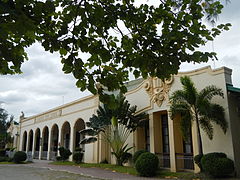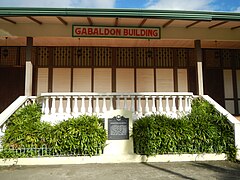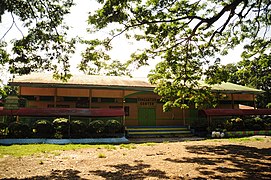
The Philippine General Hospital, simply referred to as UP–PGH or PGH, is a tertiary state-owned hospital administered and operated by the University of the Philippines Manila. It is designated as the National University Hospital, and the national government referral center. It stands within a 10-hectare (25-acre) site located at the UP Manila Campus in Ermita, Manila. PGH has 1,100 beds and 400 private beds, and has an estimated of 4,000 employees to serve more than 600,000 patients every year.

The president of the Philippines is the head of state, head of government and chief executive of the Philippines. The president leads the executive branch of the Philippine government and is the commander-in-chief of the Armed Forces of the Philippines.

Lorna Regina "Loren" Bautista Legarda is a Filipina politician, environmentalist, cultural worker, and former journalist who is currently serving as a Senator and the incumbent president pro tempore of the Senate of the Philippines since 2022. This also makes her the first woman to serve as Senate President Pro Tempore in the upper chamber's history. Before entering politics, she began her career as a news reporter until becoming a news anchor. She previously served three terms in the Senate from 1998 to 2004 and from 2007 to 2019. She is the longest-serving female Senator in the history of the Senate, and the only female in the Philippines to top two senatorial elections: 1998 and 2007. Legarda was also the House Deputy Speaker during her three-year stint as the representative of Antique from 2019 to 2022.
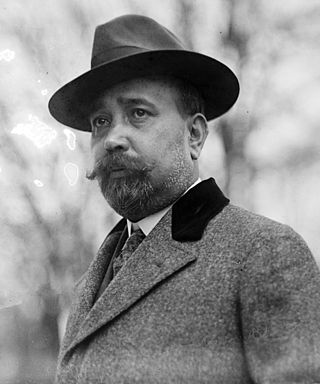
Isauro Gabaldón y González was a resident commissioner of the Philippines to the United States House of Representatives, serving from 1920 until 1928.

The bahay kubo, kubo, or payag is a type of stilt house indigenous to the Philippines. It often serves as an icon of Philippine culture. The house is exclusive to the lowland population of unified Spanish conquered territories. Its design heavily influenced the colonial-era bahay na bato architecture.

This article covers the history of the current Philippine republican state following the 1986 People Power Revolution, known as the Fifth Philippine Republic.

Rodrigo Roa Duterte, also known as Digong, Rody, and by the initials DU30 and PRRD, is a Filipino lawyer and politician who served as the 16th president of the Philippines from 2016 to 2022. He is the chairperson of PDP–Laban, the ruling political party in the Philippines during his presidency. Duterte is the first president of the Philippines to be from Mindanao, and is the oldest person to assume office, beginning his term at age 71.
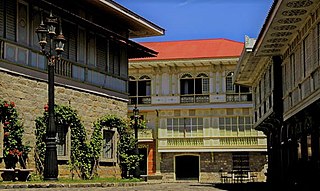
The architecture of the Philippines reflects the historical and cultural traditions in the country. Most prominent historic structures in the archipelago are influenced by Austronesian, American architectures.

The National Museum of the Philippines is an umbrella government organization that oversees a number of national museums in the Philippines including ethnographic, anthropological, archaeological, and visual arts collections. From 1973 until 2021, the National Museum served as the regulatory and enforcement agency of the government of the Philippines in the restoring and safeguarding of significant cultural properties, sites, and reservations throughout the Philippines. The mandate has since been transferred to the National Commission for Culture and the Arts.
The Constitution of the Philippines is the constitution or the supreme law of the Republic of the Philippines. Its final draft was completed by the Constitutional Commission on October 12, 1986, and ratified by a nationwide plebiscite on February 2, 1987.

Ancestral houses of the Philippines or Heritage Houses are homes owned and preserved by the same family for several generations as part of the Filipino family culture. It corresponds to long tradition by Filipino people of giving reverence for ancestors and elders. Houses could be a simple house to a mansion. The most common ones are the "Bahay na Bato". Some houses of prominent families had become points of interest or museums in their community because of its cultural, architectural or historical significance. These houses that are deemed of significant importance to the Filipino culture are declared Heritage House by the National Historical Commission of the Philippines (NHCP), previously known as the National Historical Institute (NHI) of the Philippines. Preservation is of utmost importance as some ancestral houses have come into danger due to business people who buy old houses in the provinces, dismantle them then sell the parts as ancestral building materials for homeowners wishing to have the ancestral ambiance on their houses. These ancestral houses provide the current generation a look back of the country's colonial past through these old houses.

The Philippine Space Agency (PhilSA) is the national space agency of the Philippines.

Rodrigo Duterte's six-year tenure as the 16th President of the Philippines began on June 30, 2016, succeeding Benigno Aquino III. He was the first president from Mindanao, the first president to have worked in all three branches of government, and the oldest to be elected. He won the election amid growing frustration with post-EDSA governance that favored elites over ordinary Filipinos. His tenure ended on June 30, 2022.

Ronald Marapon dela Rosa, also known as Bato, is a Filipino politician and retired police officer who is currently serving as a senator of the Philippines since 2019. He served under the Duterte administration as the chief of the Philippine National Police from July 1, 2016, to April 19, 2018, overseeing the government's anti-drug campaign; he also served as the Director General of the Bureau of Corrections from April 30 to October 12, 2018.
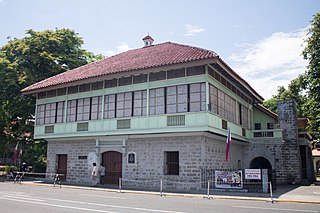
Bahay na bato, also known in Cebuano as balay na bato or balay nga bato and in Spanish as casa Filipino, is a type of building originating during the Spanish colonial period of the Philippines. It is an updated version of the traditional bahay kubo of the Christianized lowlanders, known for its use of masonry in its construction, using stone and brick materials and later synthetic concrete, rather than just full organic materials of the former style. Its design has evolved throughout the ages, but still maintains the bahay kubo's architectural principle, which is adapted to the tropical climate, stormy season, and earthquake-prone environment of the whole archipelago of the Philippines, and fuses it with the influence of Spanish colonizers and Chinese traders. It is one of the many architecture throughout the Spanish Empire known as Arquitectura mestiza. The style is a hybrid of Austronesian, Spanish, and Chinese; and later, with early 20th-century American architecture, supporting the fact that the Philippines is a result of these cultures mixing. Its most common appearance features an elevated, overhanging wooden upper story standing on wooden posts in a rectangular arrangement as a foundation. The posts are placed behind Spanish-style solid stone blocks or bricks, giving the impression of a first floor. Still, the ground level contains storage rooms, cellars, shops, or other business-related functions. The second floor is the elevated residential apartment, as it is with the bahay kubo. The roof materials are either tiled or thatched with nipa, sago palm, or cogon, with later 19th-century designs featuring galvanization. Roof styles are traditionally high pitched and are include the gable roof, hip roof, East Asian hip roof, and the simpler East Asian hip-and-gable roof. Horses for carriages are housed in stables called caballerizas.

The Philippine Identification System ID, also known as the Philippine Identification Card or simply the national ID, is the official national identity card for Filipino citizens worldwide and foreign permanent residents in the Philippines. The document is a significant part of the Philippine Identification System (PhilSys), the national identification system to be implemented by the Philippine government.
Heritage management in the Philippines is guided by laws and agencies that create regulations for potentially destructive behaviors such as excavations and demolition. Legislation pertaining to heritage management consists of Republic Acts and Presidential Decrees. Organizations such as UNESCO, the National Commission for Culture and the Arts, and the Heritage Conservation Society are also referred to in laws.

The Department of Migrant Workers is the executive department of the Philippine government responsible for the protection of the rights and promote the welfare of Overseas Filipino Workers (OFW) and their families. The department was created under the Department of Migrant Workers Act that was signed by President Rodrigo Duterte on December 30, 2021. The functions and mandate of the Philippine Overseas Employment Administration (POEA) will serve as the backbone of the department and absorbing the seven offices of the Department of Labor and Employment (DOLE) and Department of Foreign Affairs (DFA) namely the Office of the Undersecretary for Migrant Workers' Affairs (OUMWA) of the DFA, Philippine Overseas Labor Office (POLO), International Labor Affairs Bureau (ILAB), National Reintegration Center for OFWs (NRCO) and the National Maritime Polytechnic (NMP) of the DOLE. The Overseas Workers Welfare Administration will serve as its attached agency and the DMW secretary will serve as the concurrent chairperson of OWWA.
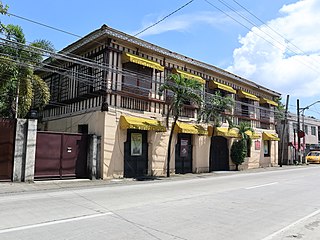
Camiña Balay Nga Bato, formerly known as Avanceña House, is a century-old heritage house in the Arevalo district, Iloilo City, Philippines. It was built in 1865 and was designed by the first parish priest of Molo, Anselmo Avanceña, for Don Fernando Avanceña and his wife, Eulalia Abaja. It was then passed on from one family to another until it came under the Camiñas family.[1] It is now owned by the fourth generation of the original owners, Gerard Camiña, former director of the Land Transportation Office in Western Visayas, and his wife, Luth Camiña. The ancestral house was declared as an "important cultural property" by the National Museum in 2015.

